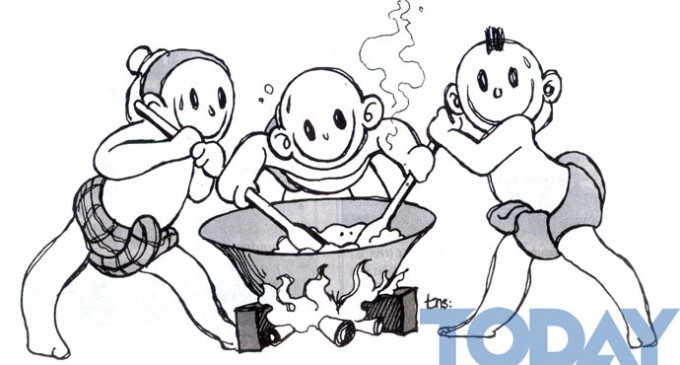THE HARVEST FESTIVAL-THE HTAMANE RESPECT FOR TOP PRIORITIES

Come Tabodwe (February), the eleventh month of the Myanmar calendar, we have the harvest festival and the making of htamane, a concoction of glutinous rice, coconut slices, sesame seeds, peanuts and generous amount of cooking oil.
Among the Myanmar, there is a tradition to observe a custom which is called “top priority for those to whom respect is due”.
In small towns and villages rice is still cooked in an earthen pot with a humped lid, so the cooked rice has a peaked shape at the top. This crown of rice is reserved for the shrine and monks. If a Myanmar comes by a rare delicacy, he would set aside a portion for ‘top priorities’. The rarer the thing, the more care he would take to do so.
Among the agrarian people in the country, it is the custom to set aside the first and with an expert movement she tosses grains up in the air. The grains fall into the tray while most of the dust and trash are blown away.
The next thing is the ‘roll’ the grains moving the tray in circular motion, so that all the dust and trash will separate from the good ones. This task is an art that calls for the highest from of virtuosity.
Boys and men tear away the fibers of the coconut until the shell inside makes its appearance. This also calls for dexterity, strength and experience. The shell is broken and the milk inside is shared by the deserving workers. The kernel is taken out and sliced on a carpenter’s plane.
 Girls shell the peanuts; the seeds are put on a flat tray and a fair-sized bottle is rolled over them to remove the thin husk. Meanwhile a giant concave iron pot is put over the fire-place, a pit dug for the purpose. Cooking oil is sizzling and shredded ginger is the first to go in and then the glutinous rice which has been soaked in water.
Girls shell the peanuts; the seeds are put on a flat tray and a fair-sized bottle is rolled over them to remove the thin husk. Meanwhile a giant concave iron pot is put over the fire-place, a pit dug for the purpose. Cooking oil is sizzling and shredded ginger is the first to go in and then the glutinous rice which has been soaked in water.
A large cauldron of water is kept ready to be added to the glutinous rice cooking in the pot. When the rice is soft enough, the pot is removed from the fire and two stalwart men, each with a huge wooden ladle, begin to stir the rice crushing it between the ladles. Even as they stir and crush, the glutinous rice gets stickier and they have to use not only their strength but their skill to make the coagulate mass yield to their ladles.
After some time of vigorous stirring and crushing, people come round to add sliced coconuts and peanuts to make the whole thing a good mixture. Sesame seeds are added last. This last does not call strength, but it needs skill, so they say. While the men are pitting their strength to stir and mix the glutinous rice, coconuts and peanuts, the one who spreads sesame seeds’ fist by, sprinkling the seeds by handfuls at regular intervals. The blend and the flavour of htamane depends on the sesame seed sprinkler, it is said.
‘Sprinkling sesame seeds’ is a Myanmar idiom, not meant, I am afraid, to describe some commendable work, but to disparage something done by some one, only after others have already done the dirty work.
Come to think of it, I am perhaps, doing the same thing. Whatever participation I have in the festival is my appreciation of htamane and the propagation of the creed. I am sprinkling sesame seeds, figuratively, by writing this article. This goes to show that the pen is mightier than the giant ladles that stir the htamane pots.
Khin Myo Chit
./wp-content/uploads/2018/10/Emirate-Online-TDY.png)
















There are no comments at the moment, do you want to add one?
Write a comment